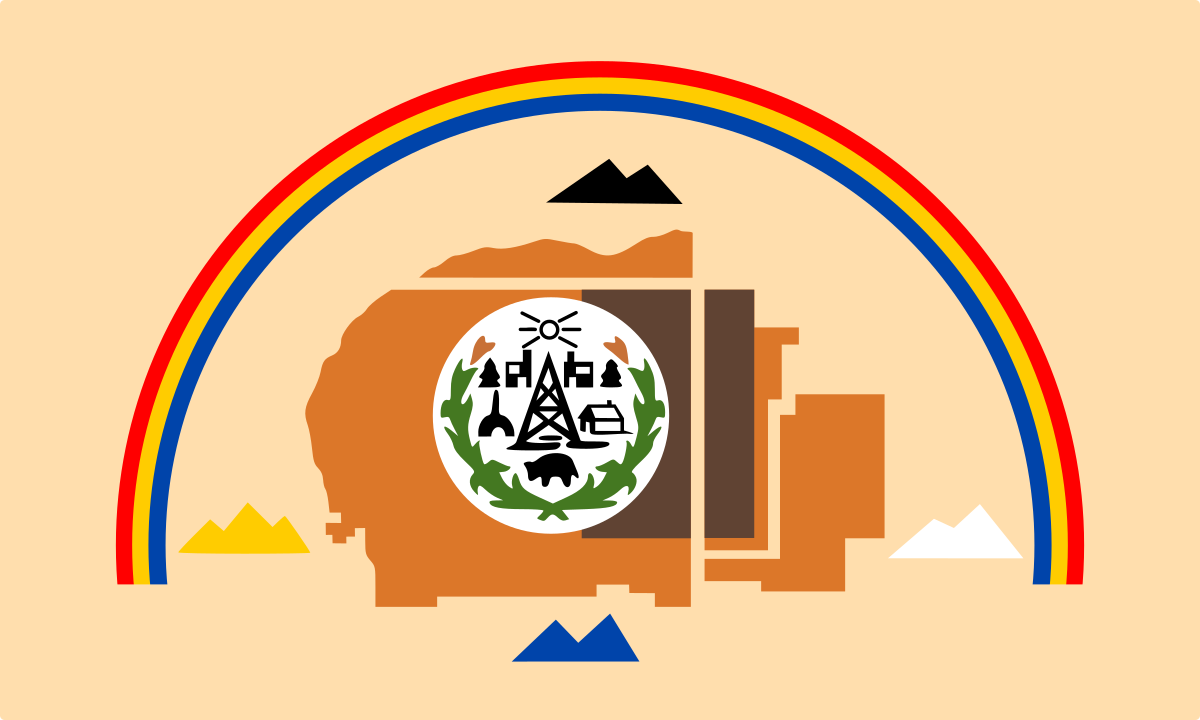The Navajos are speakers of a Na-Dené Southern Athabaskan language which they call Diné bizaad (lit. 'People's language'). They refer to themselves as the Diné, meaning (the) people. The language comprises two geographic, mutually intelligible dialects. The Apache languages are closely related to the Navajo Language; the Navajos and Apaches migrated from northwestern Canada and eastern Alaska, where the majority of Athabaskan speakers reside.Additionally, some Navajos speak Navajo Sign Language, which is either a dialect or a daughter of Plains Sign Talk. Some also speak Plains Sign Talk itself.
The Navajo religion teaches that they traveled through three or four worlds beneath this one, emerging into this world in southwestern Colorado or northwestern New Mexico. The gods created the four sacred mountains–Blanca Peak and Hesperus Peak in Colorado, Mount Taylor in New Mexico, and the San Frnacisco Peaks in Arizona. The mountains serve as supernatural boundaries, within which all was safe and protected.
Scholars still debate when the Navajo entered the Southwest. Most anthropologists agree the Navajo were spread through northern New Mexico, southern Utah and northern Arizona by the end of the 1500’s.
By 1525 A.D., the Navajo had developed a rich culture in the area near present day Farmington, New Mexico. The arrival of the Spanish in the 16th century introduced sheep, goats and horses to the Navajo. The Navajo flourished and migrated via extended family units into northern Arizona and southeastern Utah. Around 1700, and possibly as early as 1620, the Navajo moved into the San Juan River area of Utah in search of pasture land for their sheep and goat herds. Because the San Juan River was one of the few sources of water in Navajo territory, many Navajo planted fields of corn, beans, and squash on its floodplains.
A conflict arose between the Spanish and Pueblo peoples known as the Pueblo Revolt. During this time, Pueblo Indians had experienced enough of Spanish oppression and fought the Spanish, ejecting them from Pueblo land. When the Spanish returned around 1680, the Pueblo Indians sought refuge among the Navajo. The Navajo welcomed the Pueblo Indians and adopted some of their cultural values.
In the late 18th century, the Spanish, intent on conquering the Southwest, were in conflict with the Navajos. The Spanish formed alliances with the Comanches and Utes to weaken the Navajos.
By the time the U.S. acquired the southwest in 1848, the Navajo were among the richest Native Americans with large herds, some of which had been acquired during raids. Due to increasing tensions with white settlers in the area, in 1863, the U.S. Army, under the command of Christopher “Kit” Carson, destroyed the Navajo’s strength using a scorched earth policy. Carson forced the surrender of the Navajo and forcibly marched his captives 300 miles to Fort Sumner in central New Mexico, a journey known as The Long Walk. Hundreds died during the trek. Thousands more died during captivity as conditions at Fort Sumner imprisonment were overcrowded, undersupplied and unsanitary.
In 1868, the Treaty of Bosque Redondo was negotiated between Navajo leaders and the federal government allowing the surviving Navajos to return to a reservation on a portion of their former homeland.
The United States military continued to maintain forts on the Navajo reservation in the years after the Long Walk. By treaty, the Navajos were allowed to leave the reservation for trade, with permission from the military or local Indian agent. But economic conflicts with non-Navajos continued for many years as civilians and companies exploited resources assigned to the Navajo. The US government made leases for livestock grazing, took land for railroad development, and permitted mining on Navajo land without consulting the tribe.
During the time on the reservation, the Navajo tribe was forced to assimilate into white society. Navajo children were sent to boarding schools within the reservation and off the reservation. The first Bureau of Indian Affairs (BIA) school opened at Fort Defiance in 1870. Once the children arrived at the boarding school, their lives changed dramatically. European Americans taught the classes under an English-only curriculum and punished any student caught speaking Navajo. Other conditions included inadequate food, overcrowding, required manual labor in kitchens, fields, and boiler rooms; and military-style uniforms and haircuts.
The Indian Termination Policies, an official policy directive of the United States government from 1940 to the early 1960s and directed by multiple executive administrations (both Democrat and Republican), uranium mining operations were established across Navajo tribal lands. Although Navajo workers were initially enthusiastic about employment, the U.S. government appears to have been aware of the harmful risks associated with uranium mining since the 1930s and neglected to inform the Navajo communities.
Both the open and other, now abandoned, uranium mines have continued to poison and pollute land, water and air of Navajo communities today.
Nowdays the Navajo Nation is the largest federally recognized tribe in the United States with more than 399,494 enrolled tribal members as of 2021. additionally, the Navajo Nation has the largest reservation in the country. The reservation straddles the Four Corners region and covers more than 27,325 square miles (70,000 square km) of land in Arizona, Utah, and New Mexico. The Navajo language is spoken throughout the region, and most Navajos also speak English.
In 1923, a tribal government was established to help meet the increasing desires of American oil companies to lease Navajoland for exploration. Navajo government has evolved into the largest and most sophisticated form of American Indian government.
The Navajo Tribal Council was re-organized in 1991 into a three-branch government — executive, legislative and judicial — patterned after the U.S. Government. The Navajo council has 88 delegates representing 110 communities.
The Navajo Nation flag depicts the outline of the Navajo Nation in copper; the original 1868 reservation border is shown in dark brown. The four sacred mountains are shown in their cardinal directions. The rainbow symbolizes Navajo sovereignty, while the sun above two cornstalks and animals shows the traditional economy. Between a hogan and modern house, an oil derrick references another aspect of the Navajo economy.
The Indigenous Paleolithic of the Western Hemisphere
Megathreads and spaces to hang out:
- ❤️ Come listen to music and Watch movies with your fellow Hexbears nerd, in Cy.tube
- 💖 Come talk in the New Weekly Queer thread
- 💛 Read and talk about a current topics in the News Megathread
- 💚 Come and talk in the Daily Bloomer Thread
- ⭐️ September Movie Nominations ⭐️
reminders:
- 💚 You nerds can join specific comms to see posts about all sorts of topics
- 💙 Hexbear’s algorithm prioritizes comments over upbears
- 💜 Sorting by new you nerd
- 🌈 If you ever want to make your own megathread, you can reserve a spot here nerd
- 🐶 Join the unofficial Hexbear-adjacent Mastodon instance toots.matapacos.dog
Links To Resources (Aid and Theory):
Aid:
Theory:






